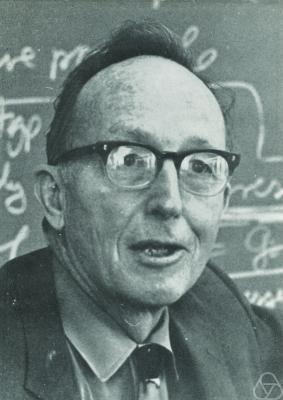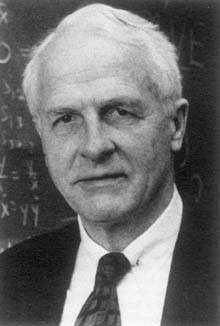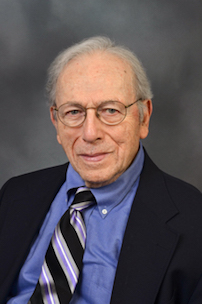Related Research Articles
In mathematics, a distributive lattice is a lattice in which the operations of join and meet distribute over each other. The prototypical examples of such structures are collections of sets for which the lattice operations can be given by set union and intersection. Indeed, these lattices of sets describe the scenery completely: every distributive lattice is—up to isomorphism—given as such a lattice of sets.

Saunders Mac Lane, born Leslie Saunders MacLane, was an American mathematician who co-founded category theory with Samuel Eilenberg.
A lattice is an abstract structure studied in the mathematical subdisciplines of order theory and abstract algebra. It consists of a partially ordered set in which every pair of elements has a unique supremum and a unique infimum. An example is given by the power set of a set, partially ordered by inclusion, for which the supremum is the union and the infimum is the intersection. Another example is given by the natural numbers, partially ordered by divisibility, for which the supremum is the least common multiple and the infimum is the greatest common divisor.

Geometric group theory is an area in mathematics devoted to the study of finitely generated groups via exploring the connections between algebraic properties of such groups and topological and geometric properties of spaces on which these groups can act non-trivially.
Norman Levinson was an American mathematician. Some of his major contributions were in the study of Fourier transforms, complex analysis, non-linear differential equations, number theory, and signal processing. He worked closely with Norbert Wiener in his early career. He joined the faculty of the Massachusetts Institute of Technology in 1937. In 1954, he was awarded the Bôcher Memorial Prize of the American Mathematical Society and in 1971 the Chauvenet Prize of the Mathematical Association of America for his paper A Motivated Account of an Elementary Proof of the Prime Number Theorem. In 1974 he published a paper proving that more than a third of the zeros of the Riemann zeta function lie on the critical line, a result later improved to two fifths by Conrey.

Garrett Birkhoff was an American mathematician. He is best known for his work in lattice theory.
Bernard Osgood Koopman was a French-born American mathematician, known for his work in ergodic theory, the foundations of probability, statistical theory and operations research.

Barry Martin Simon is an American mathematical physicist and was the IBM professor of Mathematics and Theoretical Physics at Caltech, known for his prolific contributions in spectral theory, functional analysis, and nonrelativistic quantum mechanics, including the connections to atomic and molecular physics. He has authored more than 400 publications on mathematics and physics.

In mathematics, the lattice of subgroups of a group is the lattice whose elements are the subgroups of , with the partial ordering being set inclusion. In this lattice, the join of two subgroups is the subgroup generated by their union, and the meet of two subgroups is their intersection.
James Burton Ax was an American mathematician who made groundbreaking contributions in algebra and number theory using model theory. He shared, with Simon B. Kochen, the seventh Frank Nelson Cole Prize in Number Theory, which was awarded for a series of three joint papers on Diophantine problems.

William Fogg Osgood was an American mathematician.

James Gilbert Glimm is an American mathematician, former president of the American Mathematical Society, and distinguished professor at Stony Brook University. He has made many contributions in the areas of pure and applied mathematics.
Leonidas (Leon) Alaoglu was a mathematician best known for Alaoglu's theorem on the weak-star compactness of the closed unit ball in the dual of a normed space, also known as the Banach–Alaoglu theorem.

Toshiyuki Kobayashi is a Japanese mathematician known for his original work in the field of Lie theory, and in particular for the theory of discontinuous groups (lattice in Lie groups) and the application of geometric analysis to representation theory. He was a major developer in particular of the theory of discontinuous groups for non-Riemannian homogeneous spaces and the theory of discrete breaking symmetry in unitary representation theory.

George Daniel Mostow was an American mathematician, renowned for his contributions to Lie theory. He was the Henry Ford II (emeritus) Professor of Mathematics at Yale University, a member of the National Academy of Sciences, the 49th president of the American Mathematical Society (1987–1988), and a trustee of the Institute for Advanced Study from 1982 to 1992.

Paul Roesel Garabedian was a mathematician and numerical analyst. Garabedian was the Director-Division of Computational Fluid Dynamics at the Courant Institute of Mathematical Sciences, New York University. He is known for his contributions to the fields of computational fluid dynamics and plasma physics, which ranged from elegant existence proofs for potential theory and conformal mappings to the design and optimization of stellarators. Garabedian was elected a member of the National Academy of Sciences in 1975.

Charles Bradfield Morrey Jr. was an American mathematician who made fundamental contributions to the calculus of variations and the theory of partial differential equations.

George David Birkhoff was one of the top American mathematicians of his generation. He made valuable contributions to the theory of differential equations, dynamical systems, the four-color problem, the three-body problem, and general relativity. Today, Birkhoff is best remembered for the ergodic theorem. The George D. Birkhoff House, his residence in Cambridge, Massachusetts, has been designated a National Historic Landmark.
Lois Wilfred Griffiths was an American mathematician and teacher. She served as a researcher, mathematician, and professor for 37 years at Northwestern University before retiring in 1964. She is best known for her work in polygonal numbers. She published multiple papers and wrote a textbook, Introduction to the Theory of Equations, published in 1945.
In the mathematical disciplines of in functional analysis and order theory, a Banach lattice(X,‖·‖) is a complete normed vector space with a lattice order, , such that for all x, y ∈ X, the implication holds, where the absolute value |·| is defined as
References
- Garrett Birkhoff (1988). "Mathematics at Harvard, 1836–1944". In Peter Duren; Richard A. Askey; Uta C. Merzbach (eds.). A Century of Mathematics in America — Part II (PDF). History of Mathematics. Vol. 2. Providence, RI: American Mathematical Society. pp. 3–58. ISBN 0-8218-0130-9.
- Haverford College Bulletin, Vol. 35–36, 1936–1938
- ↑ Whitman (1946), p. 522
- ↑ Birkhoff, Whitman (1949), p. 136
- ↑ Haverford Bulletin p. 12 (= vol.35, p. (6))
- ↑ Haverford Bulletin p. 125 (= vol 35., p. 99)
- ↑ Haverford Bulletin p. 429 (= vol.36, p. 101)
- ↑ Haverford Bulletin p. 433
- ↑ Haverford Bulletin, p. 128, 432
- ↑ Haverford Bulletin p. 428 (= vol.36, p. 100)
- ↑ Birkhoff (1988), p. 50
- ↑ Birkhoff (1988), p. 24
- ↑ Record at Harvard library
- ↑ Haverford News, Vol.33, No.5, Tue 28 Oct 1941, p. 8 (7)
- ↑ Bulletin of the AMS, Jul 1947, p. 715
- ↑ Notices of the AMS Vol.42, No.12, Dec.1995, p. 1555